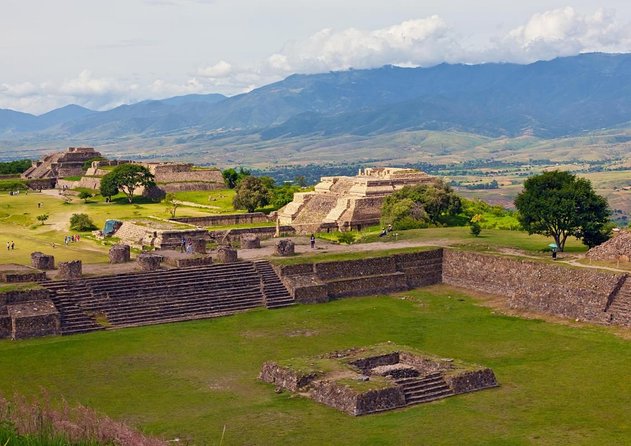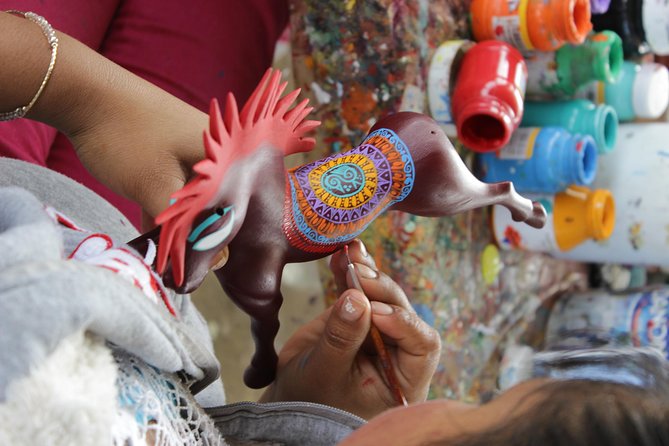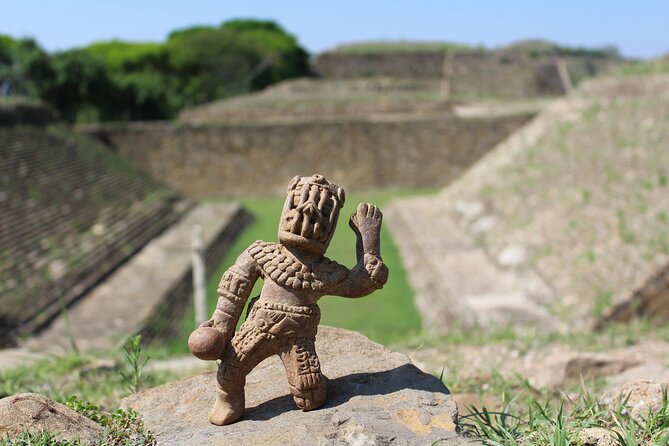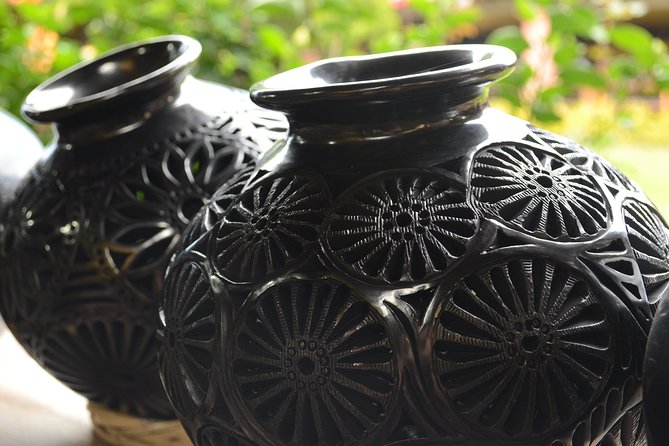Oaxaca’s cultural landscape is a tapestry of rich histories and vibrant artistic traditions. From the majestic ruins of Monte Albán to the captivating woodcarvings of Arrazola, this region offers a unique glimpse into the legacies of the Zapotec people and colonial influences. Delving deeper, the Cuilapam Convent chronicles the complexities of religious conversion, while San Bartolo Coyotepec showcases the enduring pride and artistry of the local community. Uncovering these interwoven stories, visitors embark on a captivating journey through Oaxaca’s cultural treasures, each site unveiling the multifaceted narratives that define this remarkable destination.
Key Points

- The tour offers visits to the UNESCO-listed Monte Albán archaeological site, the alebrije woodcarving town of Arrazola, the 16th-century Cuilapam Convent, and the black pottery hub of San Bartolo Coyotepec.
- At Monte Albán, the tour explores well-preserved structures, ancient ball courts, temples, tombs, and rock carvings, with a knowledgeable guide providing insights into the Zapotec civilization.
- In Arrazola, visitors can watch local artisans crafting the colorful and fantastical alebrije wooden figurines, a renowned traditional craft of the region.
- The Cuilapam Convent offers a glimpse into the colonial-era efforts to convert indigenous communities, highlighting the complex relationship between Spanish and indigenous cultures.
- San Bartolo Coyotepec is known for its distinctive black pottery, and the tour includes a visit to the local craft market and the Oaxaca State Museum of Popular Art.
Tour Overview

This full-day guided trip from Oaxaca City provides a comprehensive exploration of Monte Albán and the surrounding cultural sites.
Visitors will start their journey at the UNESCO-listed Monte Albán, where they’ll discover ancient ball courts, temples, tombs, and the renowned rock carvings known as ‘The Dancers.’
The tour then ventures to the picturesque town of San Antonio Arrazola, renowned for its vibrant woodcarvings called alebrijes.
Next, the group will visit the 16th-century Cuilapam Convent, with its unfinished basilica, before concluding in San Bartolo Coyotepec, famous for its distinctive black pottery and the Oaxaca State Museum of Popular Art.
Throughout the day, travelers will enjoy hotel pickup and drop-off, a professional guide, and a brunch-style meal.
You can also read our reviews of more tours and experiences in Oaxaca City.
Meeting and Pickup Details
The tour begins with pickup from the Quinta Real Oaxaca at 8:30 AM for an 8:00 AM start, with the total tour duration lasting approximately 11 hours from pickup to drop-off.
Travelers will be taken in an air-conditioned vehicle to the day’s destinations, which include:
-
The UNESCO-listed archaeological site of Monte Albán
-
The artisan town of San Antonio Arrazola
-
The 16th-century Cuilapam Convent
-
The pottery hub of San Bartolo Coyotepec
Throughout the journey, a professional guide will provide cultural insights and historical context.
Guests can expect a comprehensive experience exploring Oaxaca’s rich heritage and traditional crafts.
Exploring Monte Albán

Visitors to Monte Albán will uncover a treasure trove of ancient Mesoamerican wonders. The UNESCO-listed archaeological site boasts well-preserved ball courts, temples, tombs, and intricate rock carvings known as The Dancers.
Spend about 2.5 hours exploring the Grand Plaza, where ceremonial platforms and 170 tombs offer a glimpse into the lives of the Zapotec civilization. Marvel at the incredible craftsmanship and the sheer scale of this once-thriving metropolis.
Wander through the site’s steep hillsides and learn about the religious and astronomical significance of the structures. With a knowledgeable guide, visitors can uncover the rich history and cultural legacy of this ancient Mesoamerican wonder.
Discovering Arrazola
After exploring the grandeur of Monte Albán, visitors can enjoy the vibrant artistry of San Antonio Arrazola, known for its exquisite woodcarvings called alebrijes.
This charming village is a hub for local artisans who skillfully craft these fantastical creatures from wood, bringing their imaginative designs to life.
Visitors can:
-
Watch demonstrations of the alebrije-making process
-
Browse the colorful displays of unique, hand-painted figurines
-
Meet the artisans and learn about the cultural significance of this traditional craft
-
Purchase one-of-a-kind alebrijes as souvenirs to commemorate their journey through Oaxaca’s rich artistic heritage.
Visiting Cuilapam Convent
Following the vibrant artistry of Arrazola, the next stop on the tour is Cuilapam Convent, a 16th-century Dominican site that showcases the complex history of indigenous conversion efforts in the region.
Visitors spend about 25 minutes exploring the unfinished basilica, which reflects the challenges faced by the Spanish colonizers in converting the local Zapotec population to Christianity.
The guide provides insights into the architectural features and the fraught relationship between the Spanish and the indigenous communities.
Though the convent may not be as visually striking as some of the other sites, it offers a thought-provoking glimpse into the region’s tumultuous past and the lasting legacy of colonization.
- Hierve El Agua Guided Full Day Tour in Oaxaca
- Street Art Bike Ride
- Tour to Hierve El Agua and Mezcal Distillery (Small Groups)
- Traditional Cooking Class With Minerva Lopez
- Private Tour in Oaxaca to Tule, Mezcal, Textiles, Mitla Totally Personalized
- Shared Shuttle From Oaxaca Airport to Hotel in Oaxaca City
Experiencing San Bartolo Coyotepec
The final stop on the tour brings visitors to the charming town of San Bartolo Coyotepec, renowned for its distinctive black pottery and the impressive Oaxaca State Museum of Popular Art.
Visitors can explore the local church and browse the bustling craft market, where artisans showcase their exceptional black pottery. This unique ceramic tradition, known as barro negro, is a source of immense pride for the community.
The museum provides a rundown of Oaxaca’s vibrant folk art, featuring an extensive collection of alebrijes, textiles, and other traditional crafts.
Experiencing San Bartolo Coyotepec offers a fascinating glimpse into the enduring artistic heritage of the region.
Accessibility and Group Size

The tour is wheelchair accessible and stroller-friendly, accommodating travelers with diverse needs.
On top of that, the group size is capped at 20 participants, ensuring a more personalized experience. This accessibility and smaller group size allow for greater flexibility and attention from the guide, enabling them to tailor the experience to individual interests and needs.
Plus, the tour allows service animals, making it inclusive for all.
With free cancellation up to 24 hours before the start, travelers can plan their trip with confidence, knowing they can adjust their plans if necessary.
These thoughtful considerations demonstrate the tour organizer’s commitment to providing an inclusive and enjoyable experience for all participants.
Tour Reviews and Feedback
Travelers have generally praised the tour, awarding it an impressive 4.5-star rating based on 148 reviews.
Highlights include the knowledgeable guides who provide valuable cultural insights and the awe-inspiring grandeur of Monte Albán.
However, some reviewers have noted issues with cash payments for lunch and admission, as well as a lack of engagement from certain guides.
To ensure a more seamless experience, the tour operator recommends:
-
Bringing cash to cover any additional costs
-
Preparing for a long day of exploration
-
Considering smaller group tours for a more personalized experience
-
Providing feedback to the tour operator to help improve future outings.
Frequently Asked Questions
What Is the Best Time of Year to Visit These Sites?
The best time to visit these sites depends on the climate and weather conditions. Generally, the dry season from November to April offers mild temperatures and less rainfall, making it a popular and comfortable time for sightseeing.
Are Any of the Locations of Religious Significance?
Several of the locations on this tour hold religious significance. The Cuilapam Convent was a 16th-century Dominican site, while San Bartolo Coyotepec features a church. These religious sites provide insight into the area’s history and cultural traditions.
Can We Purchase Souvenirs or Local Crafts Along the Way?
Yes, the tour includes opportunities to purchase souvenirs and local crafts. Visitors can explore the artisan shops in Arrazola to browse alebrijes, and the craft market in San Bartolo Coyotepec features a variety of traditional Oaxacan pottery and textiles.
Are There Any Health or Safety Concerns During the Tour?
The tour is generally safe, but visitors should be cautious of sun exposure and stay hydrated. The walking portions may be difficult for those with mobility issues, so travelers should consider their physical abilities before booking.
How Accessible Are the Sites for Visitors With Disabilities?
The sites on this tour are wheelchair accessible, with stroller access and allowance for service animals. The tour operator accommodates visitors with disabilities, making the experience inclusive and accessible for all travelers.
Recap
This tour offers a captivating exploration of Oaxaca’s rich cultural heritage.
Visitors will discover the impressive ruins of Monte Albán, the vibrant woodcarvings of Arrazola, the colonial legacy of Cuilapam Convent, and the renowned black pottery of San Bartolo Coyotepec.
This immersive experience showcases the diverse artistry and historical significance that make Oaxaca a UNESCO World Heritage site.
More Tour Reviews in Oaxaca City
Not for you? Here's more things to do in Oaxaca City we have recnetly reviewed
- 2 Best Shopping Tours In Oaxaca City
- 3 Best Food Tours In Oaxaca City
- 3 Best Full-Day Tours In Oaxaca City
- 2 Best Lunch Experiences In Oaxaca City
- Luxury Transportation to and From Xoxocotlan Airport to Hotels
- Full Day Tour of Oaxacan Wonders
- Tasting of Organic Mezcales
- Private Arrival Transportation From Oaxaca Airport to Hotel
- Prepare an Oaxacan Mole by a Traditional Cook
- 2 Days Oaxaca Visiting Monte Albán, Mitla, Hierve El Agua, Mezcal
- Private Family Tour to Visit Monte Albán, Alebrijes and Barro Negro
- Private Transfer From Oaxaca to Huatulco
